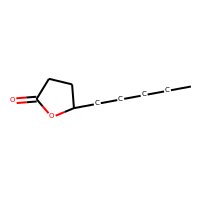
gamma-Nonalactone
| Chemical identification | |
|---|---|
| Pubchem identifier | 7710 |
| CAS identifier | 104-61-0 |
| DSSTOX identifier | DTXSID0034229 |
| IUPAC name | gamma-Nonalactone |
| SMILES | CCCCCC1CCC(=O)O1 |
| InChI | InChI=1S/C9H16O2/c1-2-3-4-5-8-6-7-9(10)11-8/h8H,2-7H2,1H3 |
| InChIKey | OALYTRUKMRCXNH-UHFFFAOYSA-N |
| Synonyms | 2(3H)-Furanone, dihydro-5-pentyl-; gamma-N-Amylbutyrolactone; gamma-Nonyllactone; Non-4-olide; Nonoic acid, 4-hydroxy-, gamma-lactone; 1,4-Nololide; gamma-Nonolactone; 4-Amyl-4-hydroxybutyric acid lactone; gamma-Pentyl-gamma-butyrolactone; gamma-Nonylactone; gamma-Nonolide; 4-Nolactone; Non-1,4-olide; Dihydro-5-pentyl-2(3H)-furanone; 4-Nonolide; Prunolide; 4-Pentyl-butanolide; gamma-Amyl-gamma-butyrolactone; gamma-Nolactone; Cocos aldehyde; 4-Hydroxynonoic acid, gamma-lactone; 1,4-Nonyl lactone; gamma-Pelargolactone; Aldehyde C-18; delta-n-Amylbutyrolactone; Coconut aldehyde |
| Odor profile | |
|---|---|
| Odor classes | Aromatic, Edible oil, Pome, Stone spices, Tropical |
| Reference | [1] |
| Presence in Children's products | |
|---|---|
| Broad category | Toys |
| Subcategory | Aquatic Toys, Squishy Toys |
| Chemical classification based on ClassyFire | |
|---|---|
| Chemical kingdom | Organic compounds |
| Chemical super-class | Organoheterocyclic compounds |
| Chemical class | Lactones |
| Chemical subclass | Gamma butyrolactones |
| Natural source for the chemical | |||
|---|---|---|---|
| Organism | Kingdom | Genus | Family |
| Brassica hirta | Plantae | Brassica | Cruciferae |
| Tipuana tipu | Plantae | Tipuana | Fabaceae |
| Coffea arabica | Plantae | Coffea | Rubiaceae |
| Cocos nucifera | Plantae | Cocos | Palmae |
| Prunus armeniaca | Plantae | Prunus | Rosaceae |
| Lavandula angustifolia ssp.delphinensis | Plantae | Lavandula | Labiatae |
| Pimpinella tirupatiensis | Plantae | Pimpinella | Apiaceae |
| Angelica dahurica | Plantae | Angelica | Apiaceae |
| Eucalyptus camaldulensis | Plantae | Eucalyptus | Myrtaceae |
| Reference | [1], [2], [3], [4], [5] | ||